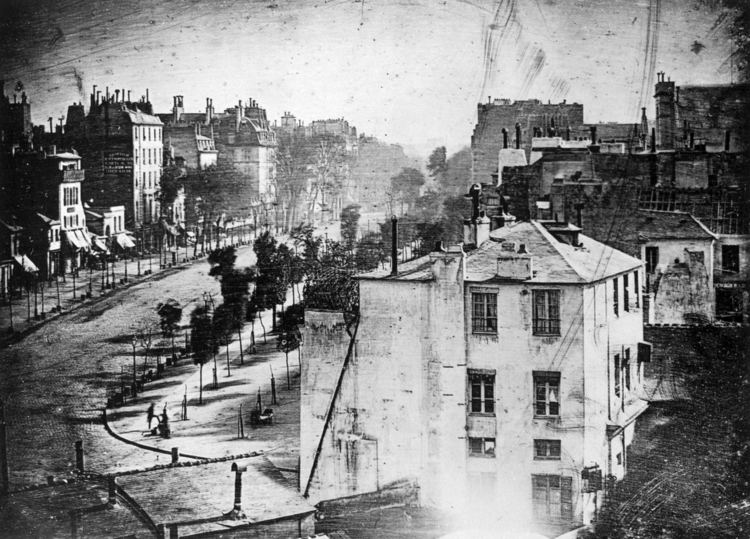The Boulevard du Temple, formerly nicknamed the "Boulevard du Crime", is a thoroughfare in Paris that separates the 3rd arrondissement from the 11th. It runs from the Place de la République to the Place Pasdeloup, and its name refers to the nearby Knights Templars' Temple where they established their Paris priory.
The Boulevard du Temple follows the path of the city wall constructed by Charles V (the so-called Enceinte, constructed between 1356 and 1383) and demolished under Louis XIV. The boulevard, lined with trees, was built between 1656 and 1705.
From the time of Louis XVI (1774–1792) until the July Monarchy in 1830, the Boulevard du Temple was popular and fashionable. It was a place for walking and recreation. Cafés and theatres previously located at the Saint-Laurent and Saint-Germain fairs moved here. After a time, it was nicknamed the Boulevard du Crime after the crime melodramas that were so popular in its many theatres. In 1782, Philippe Curtius, Madame Tussaud's tutor in wax modelling, opened his second exhibition on this Boulevard.
On this boulevard, on 28 July 1835, Giuseppe Fieschi made an attempt on the life of the king, Louis-Philippe. The attempt failed, but it resulted in 18 dead and 23 injured. Gustave Flaubert spent several months each winter at 42, boulevard du Temple from 1856 to 1869.
A photograph of this street was taken in 1838 by Louis Daguerre from high in his 350-seat Diorama Building at 4, Rue Sanson, where it intersected with the Rue des Marais, and which from the rear looked out roughly southwards over the rooftops towards Boulevard du Temple (since demolished, the place where it stood is at the south side of Rue Léon Jouhaux just off the north corner of Place de la République). The image is one of the earlier Daguerreotypes (invented 1837), and it is thus believed to be the earliest surviving photograph showing a person.
The transformations of Paris by Baron Haussmann radically modified this part of Le Marais; today, only the Théâtre Déjazet remains of the late 18th century theatres; half of them were demolished for the enlargement of the Place de la République.
The history of the names of the theatres at various sites on the boulevard du Temple is summarized in the following list. Unless otherwise noted the names and dates are from Lecomte, and the street addresses are based on the 1861 Paris guide of Lehaguez.
1759: Théâtre de Nicolet, ou des Grands Danseursmoved across the street to 58 boulevard du Temple in 1764Grands-Danseurs du Roi (acquired this name in 1772)Théâtre de la Gaîté (acquired this name in 1792)rebuilt in 1808 and 1835 after a fireThe company relocated to the rue Papin in 1862.The building on the boulevard du Temple was demolished sometime thereafter.1769: Théâtre de l'Ambigu-Comique of Nicolas-Médard Audinotlocated at 62 boulevard du Templedestroyed by fire in 1827 (relocated to 2 boulevard Saint-Martin)replaced by the Théâtre des Folies-Dramatiques (1st, 1831)expropriated in 18621774: Théâtre des Associéslocated at 52 boulevard du TempleThéâtre Amusements-Comiques (1787)Théâtre Patriotique (1790)Théâtre Sans-Prétention (1797)Closed in 1807 by Napoleon's decree on the theatres, it became the Café d'Apollon.Théâtre de Madame Saqui (1816)Théâtre du Temple (1832, a vaudeville house run by Roux, dit Dorsay)Théâtre des Délassements-Comiques (3rd, 1841, this company relocated to the rue de Provence in 1862)Théâtre du boulevard du Temple (1862, for two weeks in July, relocated to the Théâtre Lyrique, reopening with the name Théâtre Historique)The building on this site was later demolished.1779: Théâtre des Élèves pour la Danse de l'Opéraprobably located at 48 boulevard du TempleLycée-Dramatique (1791)Théâtre Lazzari (1st, 1792, also spelled Lazari or Lazary)Théâtre Français du boulevard (1793)Théâtre des Variétés-Amusantes (2nd, 1793)destroyed by fire in 17981785: Théâtre des Délassements-Comiques (1st), of Plancher ('Aristide Valcour')located between the Hôtel Foulon [site of the later Théâtre Historique] and the site of the later Cirque-OlympiqueThéâtre Lyri-Comique (1800)Théâtre des Variétés-Amusantes (3rd, 1803)Nouveaux Troubadours (1805)Closed in 1807 by Napoleon's decree on the theatres, most of the building was demolished except for the entry hall, which continued to be used for exhibiting trained dogs and monkeys performing tricks.1787: Théâtre des Bluettes comiques et lyriquesThéâtre des Élèves de Thalie (1791)1787: Cabinet des figures de cire (Cabinet of wax figures), disappeared in 18471813: Théâtre des Funambules (1st)located at 54 boulevard du TempleThe company relocated to the boulevard de Strasbourg in 1862, closing after one year.The building on the boulevard du Temple was demolished on 18 July 1862.1821: Théâtre Lazzari (2nd)located at 50 boulevard du TempleSpectacle LazzariThéâtre de Petit-LazzariThéâtre Lazzari (also spelled Lazary, demolished sometime after 1862)1821: Panorama-Dramatiquelocated at 48 boulevard du TempleThe theatre closed after 21 August 1823 and was replaced with a six-story residential building.1827: Cirque-Olympique (3rd)located at 66 boulevard du TempleOpéra-National (1st, 1847, this company reopened at the Théâtre Historique in 1851)Théâtre National du Cirque (1848)Théâtre Impérial du Cirque (1853, relocated to the theatre on the Place du Châtelet in 1862)The building on this site was later demolished.1846: Théâtre Historique (1st)located at 72 boulevard du TempleOpéra-National (2nd, 1851)Théâtre Lyrique (1st, 1852)Théâtre Historique (2nd, 1862, name revived by the Théâtre du boulevard du Temple)This building was demolished in 1863.1853: Théâtre des Folies-Concertanteslocated at 41 boulevard du Temple, on the site of the former concert-bal, the Folies-MayerThéâtre des Folies-Nouvelles (1854)Théâtre Déjazet (1859)Théâtre des Folies-Nouvelles (1872)Théâtre Déjazet (1873)Troisième Théâtre Français (1876)Théâtre des Folies-Nouvelles (1880)Théâtre Déjazet (1880–)The Boulevard du Temple is:
It is also
It is served by lines 3, 5, 8, 9, and 11.

